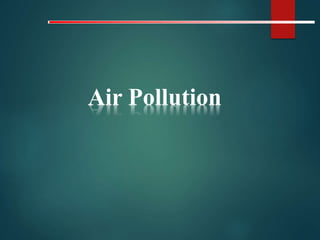
Air-Pollution.pptx
- 2. Content What is it? How is it measured? The measured pollutants SMOG Its effects..... What can you Do Conclusion References
- 4. What is Atmosphere Atmosphere is the life blanket of Earth. It is therefore essential that we know more about the atmosphere and the ways in which it is Polluted.
- 5. •Any visible or invisible particle or gas found in the air that is not part of the original, normal composition.
- 6. Natural:forest fires, pollen, dust storm Unnatural: man-made; coal, wood and other fuels used in cars, homes, and factories for energy
- 7. Air Pollution Air Pollution can impact your Health Environment Nation’s Economy
- 8. Sources of air pollution • Answer:the car ,bus,motorbike and lorry . • They cause air pollution because they have an engine which burns fuel.
- 9. Sources of air pollution • Sources of air pollution are either: Natural:caused by nature. Man-made:caused by human activity . • Below are some other sources of air pollution.Which are natural,and which are man-made? Burning fuel at home Industry Power stations Wildfire Volcanoes
- 10. Causes of Air Pollution Major sources of Air Pollution - Industries -Automobiles and Domestic fuels -High Proportion of undesirable gases, such as sulphur dioxide and carbon monoxide
- 11. CAUSES OF AIR POLLUTION Carbon dioxide-this happens because of Deforestation and fossil fuel burning. Sulfur dioxide –Due to the burning of sulfur containing compounds of fossil fuels. Sulfur oxides- very dangerous to humans at a high concentration. Sulfur in the atmosphere is responsible for acid rain.
- 12. CONSEQUENCES OF AIR POLLUTION CO2 is a good transmitter of sunlight, but it also partially restricts infrared radiation going back from the earth into space, which produces the so- called greenhouse effect that prevents a drastic cooling of the Earth during the night. CO2 in atmosphere --> GLOBAL WARMING
- 13. Effects of Air Pollution Human health Animals Plants The atmosphere as a whole
- 15. How to Avoid Air Pollution Use natural Gases, like lpg autos Do not Burst Crackers Use less Amount of Fuel for Vehicles Use electric stoves
- 17. How You Can Help Reduce Air Pollution? Conserve Energy Drive Wisely / Ride Wisely
- 19. AQI: Air Quality Index •Indicates whether pollutant levels in air may cause health concerns. •Ranges from 0 (least concern) to 500 (greatest concern)
- 22. Air Quality Air Quality Index Protect Your Health Good 0-50 No health impacts are expected when air quality is in this range. Moderate 51-100 Unusually sensitive people should consider limiting prolonged outdoor exertion. Unhealthy for Sensitive Groups 101-150 Active children and adults, and people with respiratory disease, such as asthma, should limit prolonged outdoor exertion. Unhealthy 151-200 Active children and adults, and people with respiratory disease, such as asthma, should limit prolonged outdoor exertion, everyone else, especially children should limit prolonged outdoor excertion. Very Unhealthy (Alert) 201-300 Active children and adults, and people with respiratory disease, such as asthma, should limit prolonged outdoor exertion everyone else, especially children, should limit outdoor exertion.
- 23. Efficient insulation Bacteria Molds and mildews Viruses animal dander and cat saliva plants house dust Mites Cockroaches pollen
- 31. Carbon Monoxide •Colorless, odorless •Produced when carbon does not burn in fossil fuels •Present in car exhaust •Deprives body of O2 causing headaches, fatigue, and impaired vision
- 32. Sulfur Dioxide •Produced when coal and fuel oil are burned •Present in power plant exhaust •Narrows the airway, causing wheezing and shortness of breath, especially in those with asthma
- 33. Nitrogen Dioxide •Reddish, brown gas •Produced when nitric oxide combines with oxygen in the atmosphere •Present in car exhaust and power plants •Affects lungs and causes wheezing; increases chance of respiratory infection
- 34. Particulate Matter •Particles of different sizes and structures that are released into the atmosphere •Present in many sources including fossil fuels, dust, smoke, fog, etc. •Can build up in respiratory system •Aggravates heart and lung disease; increases risk of respiratory infection
- 35. Ground Level Ozone •At upper level, ozone shields Earth from sun’s harmful UV rays •At ground level, ozone is harmful pollutants •Formed from car, power and chemical plant exhaust •Irritate respiratory system and asthma; reduces lung function by inflaming and damaging lining of lungs
- 38. •Combination of gases with water vapor and dust •Combination of words smoke and fog •Forms when heat and sunlight react gases (photochemical smog) •Occurs often with heavy traffic, high temperatures, and calm winds
- 40. •1st smog related deaths were in London in 1873; death toll 500 people; can you imagine how much worse the atmosphere is now?! •Limits visibility •Decreases UV radiation •Yellow/black color over cities •Causes respiratory problems and bronchial related deaths
- 47. •Ride your bike •Tell your friends and family about pollution •Make sure your parents get pollution checks on their cars •Ride the school bus
- 48. •Learn more; stay up to date •Join a group to stop pollution •Encourage your parents to carpool to work •Switch off lights, fan, heat, etc. when you leave the room
- 50. CONCLUSION Air pollution has long been a serious problem in the world. Without air, Earth would be unable to sustain life. Spread the Word.
- 51. Reference www.google.com www.wikipedia.com www.studymafia.org
- 52. Thanks
Editor's Notes
- 1